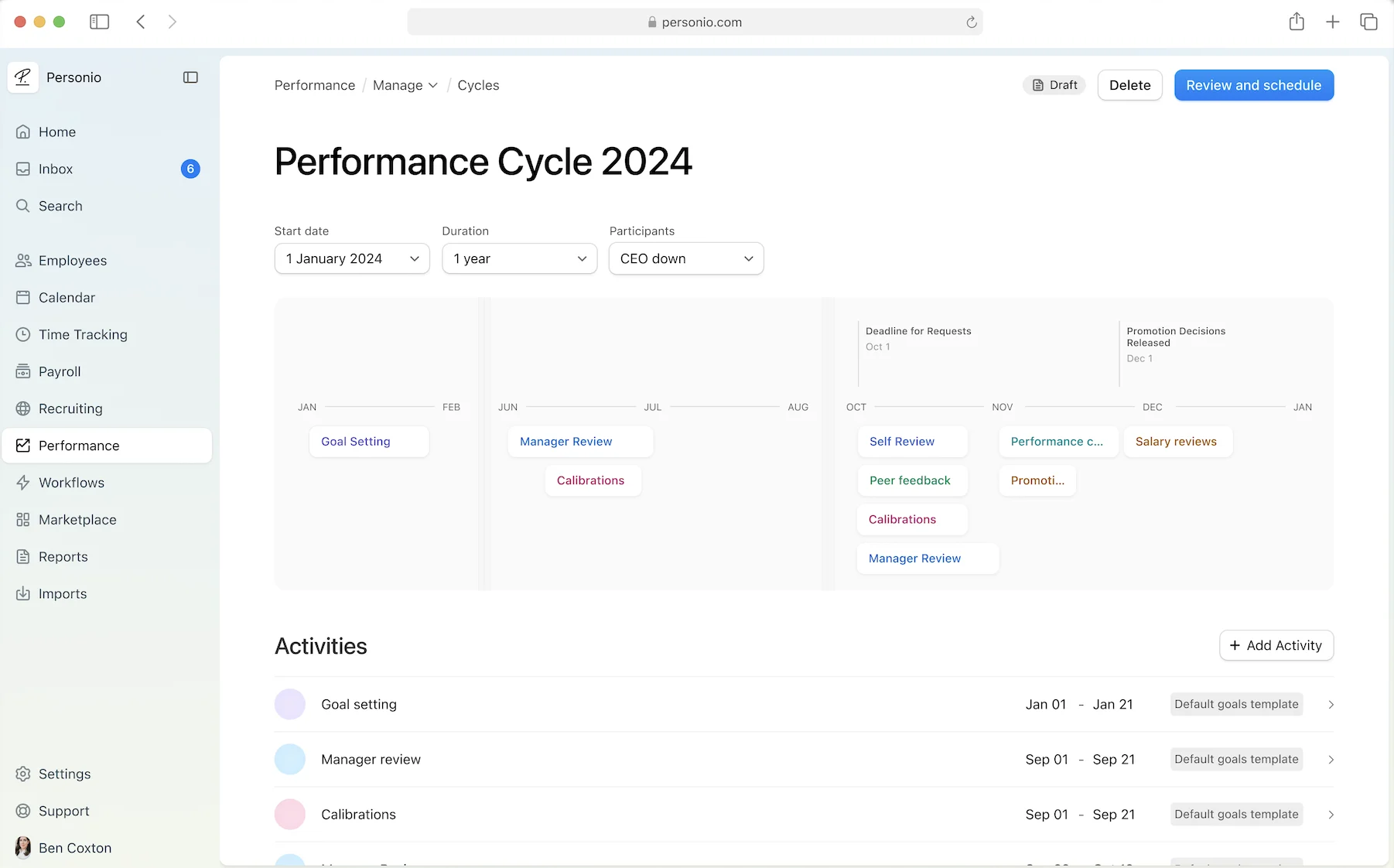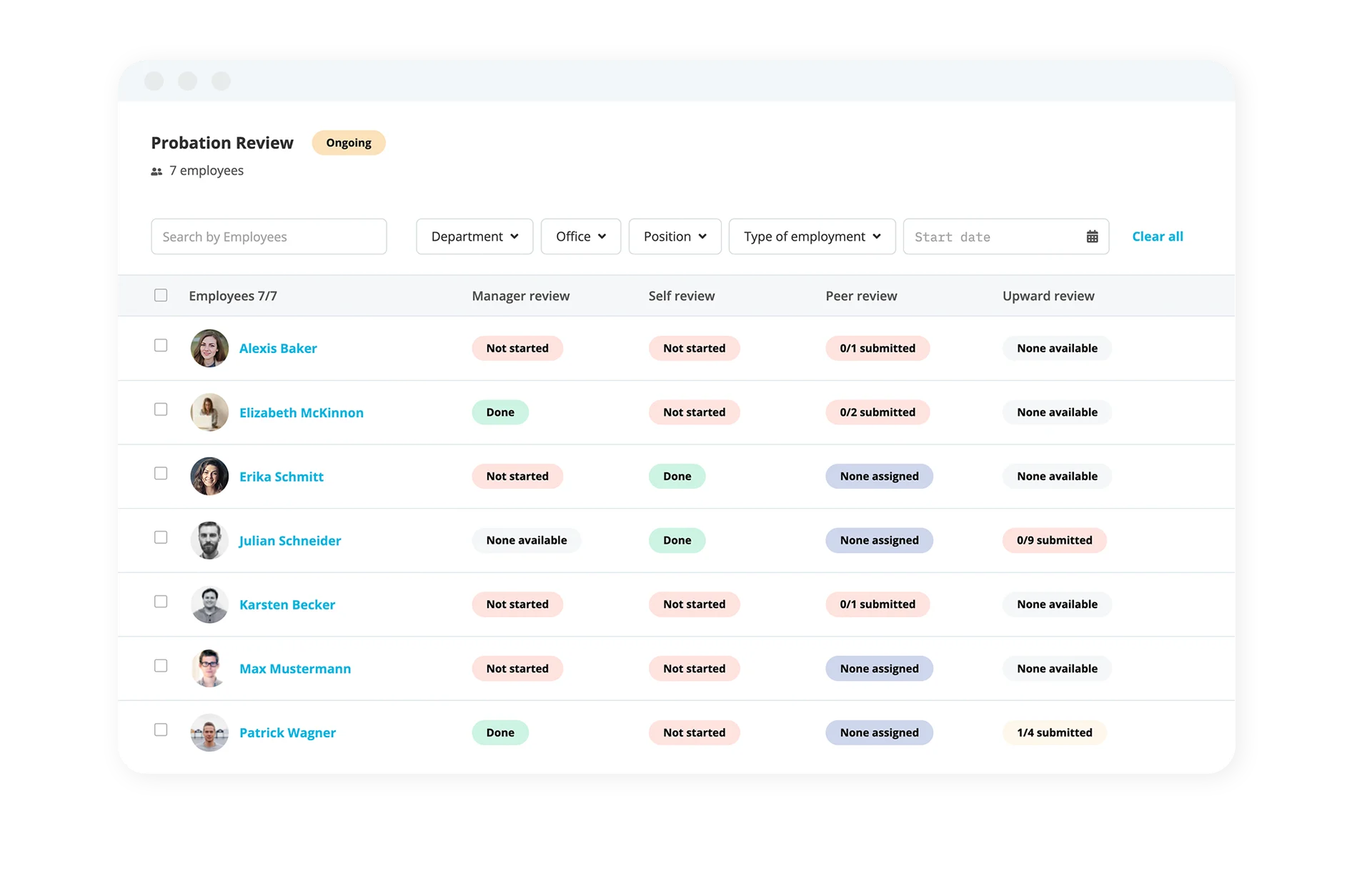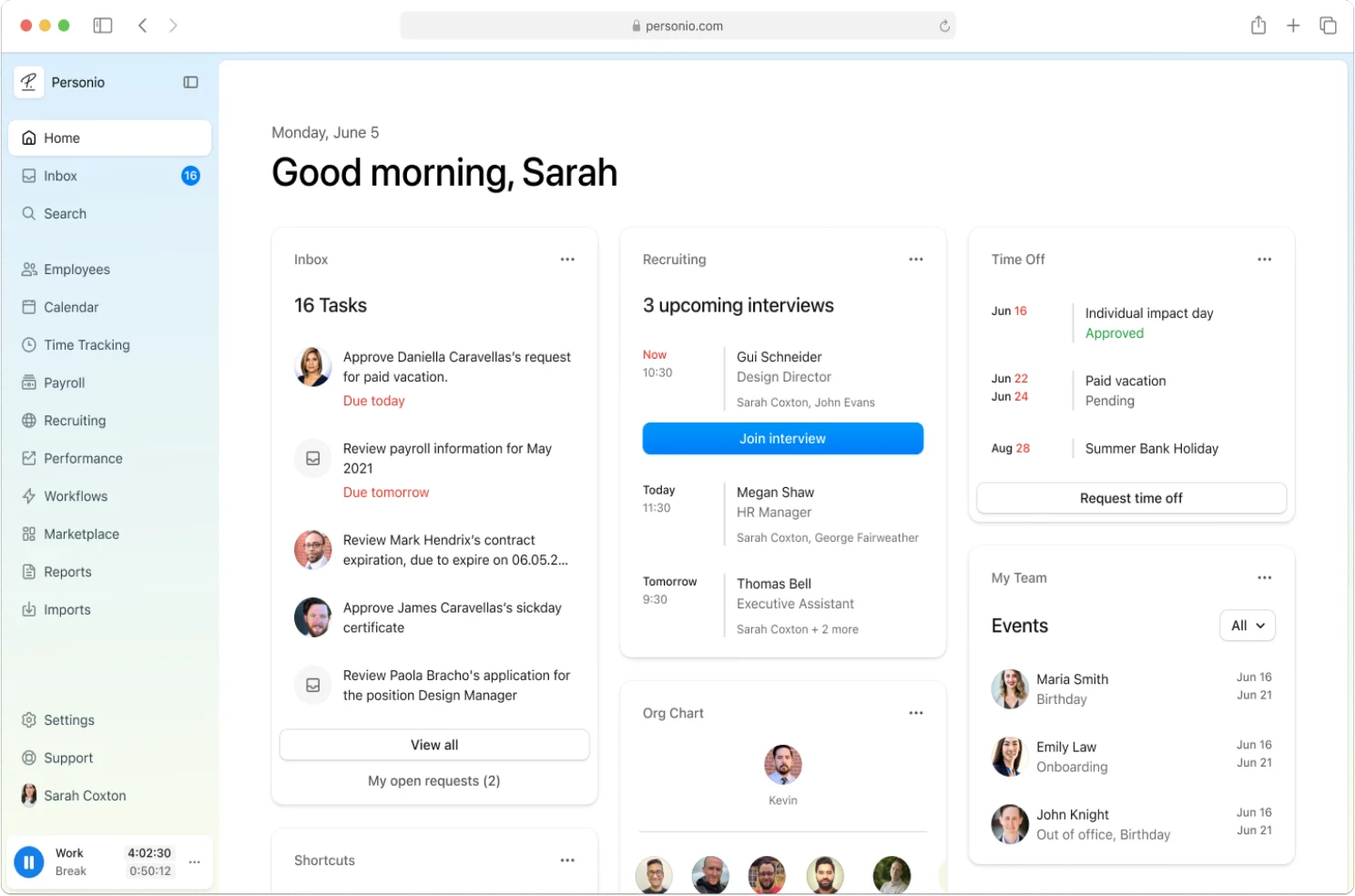
Revolutionise your processes
Check out the leading performance review software solutions to transform your workplace evaluations.
Read our guidePerformance improvement plan (PIP): Tips, examples and template

A performance improvement plan (PIP) can transform an unpleasant experience into a good one. After all, nobody likes delivering negative employee feedback, but everyone appreciates a plan to improve.
In this article, we break down exactly what goes into one of these plans, why they are so effective, and even offer a free template you can get started with today.
Kick things off by downloading our target agreement template.
Contents
- 1What is a performance improvement plan (PIP)?
- 2When is a performance improvement plan needed?
- 3Is a performance improvement plan a disciplinary step?
- 4How should you roll out a performance improvement plan?
- 5Benefits of a performance improvement plan
- 6Design a performance improvement plan in 8 steps
- 7Tips for a successful PIP
- 8Performance improvement plan examples
- 9Manage employee performance with Personio
What is a performance improvement plan (PIP)?
A performance improvement plan (PIP), also known as a performance action plan, is a formal document that outlines an employee's performance deficiencies, along with a timeline and goal-oriented plan to help them improve.
Do performance improvement plans work?
Definitely. A performance improvement plan is good for both HR and for employees, because it establishes clarity and transparency regarding performance. When you roll out a PIP process, employees will never be confused about where they standard.
After all, 65% of employees say they actually want more feedback (as long as it’s actionable and constructive). And almost a quarter of employees have considered leaving their job because their managers provide inadequate feedback.
Key takeaway: Implementing a goal-based performance improvement plan is important to maintain a culture of feedback and help employees improve (while retaining them, too).
When is a performance improvement plan needed?
Performance improvement plans are best suited for situations where an employee is underperforming but has the potential to improve. That is because they require clear and attainable goals can be set for the employee to reach.
Common problems that can be resolved with a performance improvement plan include:
Poor sales or results
Poor quality of work
Consistent tardiness or absences
Low productivity and missed deadlines
Poor client/customer feedback
Issues around behaviour or conduct aren’t as well-suited for a performance improvement plan, as it’s harder to set attainable goals for something like insubordination or harassment. Use the following links to learn more about disciplinary meetings and verbal warnings.
There may also be a personal issue that’s affecting the employee’s performance, and not necessarily an issue with their skills or training. If so, the employee may benefit more from an approved leave or increased mental health support rather than a PIP.
Is a performance improvement plan a disciplinary step?
A performance improvement plan is not designed to discipline an employee. It is meant to serve as an opportunity for them to get their performance where it needs to be.
That said, it may be a prelude to disciplinary action, but it is not fair to assume that it always would or would require it.
After all, an employee may not have intentionally done something wrong to warrant a PIP. They may simply need help improving in their work, rather than correcting a transgression or personal misconduct.
How should you roll out a performance improvement plan?
How should an HR professional or leader introduce a PIP to an underperforming employee? Of course, we want to make sure we approach this topic with the right level of care and consideration.
After all, as you can imagine, receiving a PIP can be stressful for an employee. Receiving criticism is uncomfortable, and PIPs have a reputation for being many employer’s last attempt at employee improvement before they let them go.
Employees don’t always lose their job after receiving a PIP, but the thought alone can increase stress. Luckily, as an employer, your approach to the process can change all of that.
Focus on the positives of a performance improvement plan
Instead of using a PIP to point out everything an employee is doing wrong, present it as an opportunity for the employee to learn, grow, and achieve their potential, all with the full support of their employer.
This can transform the experience for both parties, taking it from anxiety-inducing to motivational.
Benefits of a performance improvement plan
While the focus of a performance improvement plan is to address and resolve specific issues, its impact is often much greater:
Better employee experiences - Employees are more engaged when their managers help them set performance goals, which encourages them to take more pride in their work, produce better results, and increases their overall job satisfaction.
More skilled employees - Skill gaps are often the root cause of many workplace performance issues. A PIP will find those knowledge gaps, identify the training needed to fill them, and help you create an effective training schedule.
Improved relationships - Performance improvement plans often pave the way for much-needed conversations to happen. When managers and supervisors are more open and approachable, employees are more engaged in their work.
Increased employee retention - By emphasising the positive aspects of a PIP, employees will see that their employers really are supportive of them and want to see them succeed. A PIP that is presented and executed with positivity and strategy, can easily help struggling employees get back on track and improve.
Design a performance improvement plan in 8 steps
Every performance improvement plan should be highly tailored to the employee, their performance deficiencies, and the goals that will help them improve.
To design an effective PIP for every employee, follow this guide:
1. Evaluate the situation
While some employers will use PIPs as a way to document employee issues before terminating them, that’s not necessarily their best use.
A performance improvement plan is best used in a situation where an employee needs help improving in their role and performance, has the potential, and is committed to that improvement.
If the employee and their situation fit the criteria, then moving forward with a PIP is likely the best course of action.
If the employee has disengaged completely from their work and role, you as an employer can only do so much.
They may not see their issues as issues and may not be committed to improvement, in which case a verbal warning, demotion, transfer, or termination may be the necessary next step.
2. Gain insights into their performance
To confirm there’s an issue that warrants a PIP, review the employee’s performance and speak with their superior or team to get insight into their day-to-day conduct.
This is part and parcel with your performance review process and your performance appraisal objectives. To flag issues with performance, your appraisals should be designed to key in on employee performance.
Create a record of their performance deficiencies and collect documented proof of each. If the employee has received previous warnings related to their performance, review the documents and include those in the file.
Click here to discover document management with Personio.
You may also want to include details on how the employee’s performance has affected their:
Team
Project deadlines
Client/customer relationships
The company’s overall success
This is not designed to guilt the employee, of course, but to emphasize how valued and important they are to the business.
Finally, look over the employee’s most recent performance review, or multiple reviews, depending on their seniority with the company. This can often shed light on ongoing issues.
3. Hold manager reviews
Employee success is a team effort; if employees haven’t received the support, training, and continuous guidance they need from their manager or supervisor, they haven’t been set up for success.
Review the employee’s training history, onboarding experience, and how they’ve been supported by their manager or supervisor to see if there has been a lack of training or help from leadership.
Next, uncover their supervisor’s expectations and goals. Are they committed to helping this employee succeed, or are they more focused on getting them terminated? Their mindset can have a drastic impact on how successfully the PIP plays out.
This is not an employee vs employer scenario — everyone should be on the same page from the get-go and work together as one team.
4. Get started with a PIP template
With the collected information, the employee’s manager or supervisor will create a draft of the performance improvement plan, which is then reviewed by HR.
The document should cover the following:
Background and Basics:
Employee’s name, title, job description, and responsibilities
Expectations around employee’s performance levels (sales goals, projects, etc.)
Record of deficiencies with specific examples, dates, and proof
Clear Goals and Timelines:
A timeline with scheduled check-in meetings
Attainable goals set within a realistic timeframe, such as:
Hitting a certain sales target in one quarter
No late arrivals or unapproved absences for one month
No missed deadlines for three months
Completing tasks at a certain rate
How the company will support the employee (training courses, mentorship, coaching, etc.)
Consequences for not meeting the goals of the plan or not completing it
5. Have HR review
The HR department will then review the claims and proof to ensure they’re substantiated and are well-suited for a PIP, confirming the following:
The goals are attainable, relevant, and possible to achieve within the given timeframe.
There’s no bias against the employee from their manager. (If a manager would rather terminate an employee than conduct a PIP, the document may unfairly overemphasise the issues or faults of the employee.)
The employee has the tools, support, and guidance they need to achieve the goals.
6. PIP meeting
The manager, HR representative, and employee will then meet to review the plan and timelines which have been approved by the HR team.
You will want to keep the atmosphere very open and positive during this time, emphasising that you’re there to encourage and support the employee and help them reach their full potential.
Getting the employee’s input and feedback is key to nurturing a positive environment and approach. Let them ask questions and try to break down any blockers or problems that are presented.
After the meeting, you may need to modify the plan based on the employee’s input (where appropriate). When the plan is complete, it must be signed by both manager and employee and approved by HR.
7. Employee check-ins
Once the employee receives the performance improvement plan and reaches the established start date, the ball is mostly in their court.
How long does a PIP last? Typically 30, 60, or 90 days; the timeline should be tailored to an employee’s specific goals and how long it will take to accomplish them.
Schedule check-in meetings with the manager and employee throughout the course of the plan to keep the process running smoothly, and to help the employee get as much from the experience as possible.
Double-check they have all of the tools and training they need as they move forward, and keep the door open to conversation and advice if the employee needs additional support.
8. Plan completion and next steps
At the end of the performance improvement plan, arrange a closing meeting with the employee and manager to review the employee’s progress, see which goals they’ve hit, and clarify next steps.
If the employee hits their goals or finishes training before the official end of their plan, this meeting may get moved up.
Either way, it’s a great time to celebrate all that the employee has accomplished, set expectations for their job performance moving forward, and keep that positive momentum going!
Tips for a successful PIP
Here are some things to keep in mind if you want to run a successful performance improvement plan process...
Identify the root cause: Try and get to the heart of the matter. Analyse the employee's work habits, skills and environment to really determine what is holding them back. All that in mind, build a plan around addressing that issue.
Involve the employee in the process: Collaborate with your employee to develop the PIP. Ensure they have a clear understanding of their goals, responsibilities and the expectations for improvement. Their active participation can foster a sense of ownership.
Set clear and measurable goals: Establish specific, attainable, relevant, time-bound (SMART) goals that are clearly defined and understood by everyone. Any conversation regarding an employee's PIP should be bound by these goals.
Provide regular feedback and coaching: Speaking of conversations, effective feedback involves ongoing communication. Managers should be trained to offer constructive feedback and track progress in an objective and transparent way.
Document progress and outcomes: HR managers need to maintain detailed records of the employee's progress throughout the PIP process. This documentation can be helpful in evaluating the effectiveness of the plan and making adjustments as needed.
Reward success: Recognise and reward any achievements along the way. Positive reinforcement can motivate employees to continue making progress and encourage them to maintain their improved performance.
Performance improvement plan examples
Example 1: Poor attendance
Performance issue: Employee has a consistent pattern of absenteeism, resulting in missed workdays and disruptions to the overall team's workflow.
Main goal: Reduce absenteeism to an acceptable level, ideally below 5% of scheduled workdays
Measurable KPIs:
Absenteeism rate: Track the percentage of scheduled workdays the employee is absent.
On-time project completion rate: Monitor the percentage of projects completed by the employee within the agreed-upon deadlines.
Action Plan:
Meet with the employee to discuss the attendance issue and explore underlying reasons for their absences.
Provide clear expectations for attendance and outline the consequences of continued absenteeism.
Develop strategies to address potential causes of absences, such as offering flexible work arrangements or addressing health concerns.
Implement attendance tracking mechanisms and regular check-ins to monitor progress.
Provide training on effective communication practices to ensure timely updates on absences and progress.
Example 2: Not meeting deadlines
Performance Issue: Employee is consistently failing to meet deadlines for assigned tasks and projects, causing delays and disruptions to the team.
Main goal: Consistently meet deadlines for assigned tasks and projects.
Measurable KPIs:
On-time project completion rate: Track the percentage of projects completed by the employee within the agreed-upon deadlines.
Task completion rate: Monitor the percentage of tasks completed by the employee within the specified timeframe.
Action Plan:
Conduct a time management assessment to identify areas for improvement.
Provide training on time management techniques, including prioritisation, task decomposition and scheduling tools.
Implement a system for tracking project progress and deadlines.
Encourage regular communication with the supervisor regarding project status and potential challenges.
Establish clear expectations for deadlines and consequences for missed deadlines.
Example 3: Poor customer service
Performance Issue: Employee consistently receives negative feedback from customers regarding their attitude, communication skills or problem-solving abilities.
Main goal: Consistently provide exceptional customer service that meets or exceeds customer expectations.
Measurable KPIs:
Customer satisfaction ratings: Track the average customer satisfaction rating for interactions handled by the employee.
Number of customer complaints: Monitor the frequency of customer complaints related to the employee's service.
Positive customer feedback: Assess the frequency of positive customer feedback regarding the employee's service.
Action Plan:
Conduct customer service training to enhance communication, problem-solving,
and conflict resolution skills.
Provide role-playing opportunities to practice handling challenging customer interactions.
Implement a system for collecting and analysing customer feedback.
Implement a rewards and recognition program for exceptional customer service.
Regularly monitor customer feedback and provide ongoing coaching to address any ongoing issues.
Manage employee performance with Personio

Employee performance is an organisation-wide affair. To give your team the time to focus on things like crafting performance improvement plans, your performance review cycles need to run smoothly.
Personio's Performance & Development feature allows teams to run reviews, collect feedback, tie goals to bonus payouts and more. Now, your team can manage performance at scale while delivering more qualitative measures.


